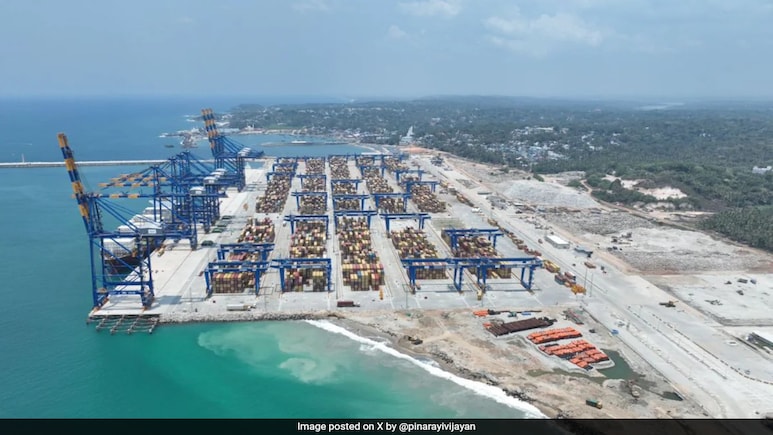
- Adani Group's Vizhinjam International Seaport handled over 1 million TEUs
- The port has served over 460 vessels, including 26 ultra-large container vessels
- Vizhinjam features 8 ship-to-shore and 24 automated cranes with AI and IoT cargo tracking
In under nine months since commencing commercial operations, Adani Group's Vizhinjam International Seaport has achieved a significant milestone of handling over 1 million twenty-foot equivalent units (TEUs). The achievement by the port operated by Adani Ports and Special Economic Zone (APSEZ) not only surpasses initial projections but has also redefined India's maritime map.
At a ceremony held at the port to commemorate the milestone, Kerala's Minister for Ports VN Vasavan said the Vizhinjam Port had handled 1 million TEUs within just nine months of beginning commercial operations. "This is a proud moment for Kerala and India as an emerging maritime power."
Second phase of the port project will begin soon, he said, adding railway and road connectivity will also be built soon.
Launched on December 3, 2024, Vizhinjam has already welcomed over 460 vessels, including 26 ultra-large container vessels (ULCVs) measuring up to 399.99 metres. The port was originally expected to handle only 30 per cent of its 1 million TEU capacity in its first year under the concession agreement. Instead, it has exceeded expectations by achieving full-scale throughput in record time.
This feat was made possible through close collaboration between the government, local communities and APSEZ. It highlights both the port's structural advantages and the Adani Group's operational expertise. More importantly, it signals India's ability to reshape global trade flows long dominated by regional hubs like Colombo and Singapore.
Vizhinjam's performance is on par with some of the world's top ports, particularly in its ability to handle larger parcel exchanges per vessel compared to Indian benchmarks. A notable example is the MSC Paloma, where the port achieved a record-breaking exchange of 10,576 TEUs - setting a new benchmark in India.
This, port officials say, reflects meticulous planning, optimized crane deployment, and high berth utilisation, all of which are crucial for sustaining growth in container traffic. Backed by APSEZ's track record of operational discipline, Vizhinjam is quickly becoming Southern India's largest container terminal by TEUs handled within its very first year.
Vizhinjam's success is rooted in both geography and technology. Located close to the main East-West shipping routes, it allows vessels to reduce transit times and costs significantly. Its natural draft of 18.5 metres means even the largest ULCVs can dock without the need for dredging - a rarity among global deep-water ports.
Complementing its natural advantages is a robust technological backbone. The port operates with 8 STC (ship-to-shore) cranes and 24 automated CRMG (cantilever rail mounted gantry) cranes, supported by AI (artificial intelligence)- and IoT (Internet of Things)-enabled systems for real-time cargo tracking. Full automation ensures precision, faster vessel turnaround times, and scalability to absorb future growth without major upgrades.
Industry sources said the rapid scale-up at Vizhinjam is shifting trade dynamics. By offering direct connectivity to Europe, the US, Africa, and the Far East, the port eliminates the need for Indian cargo to be transshipped through foreign hubs. This directly enhances India's self-reliance in maritime logistics while lowering costs and shipping times for exporters and importers.
With EXIM (export-import) operations set to commence in the fourth quarter of this financial year, the port is poised to unlock new trade opportunities, further boosting its role as a southern gateway for global commerce.
On sustainability, officials said Vizhinjam has been designed with eco-conscious infrastructure, integrating renewable energy solutions and adhering strictly to the Ministry of Environment, Forest and Climate Change (MoEFCC)safeguards. These initiatives place Vizhinjam at the forefront of India's Green Shipping Revolution, setting an example for future maritime developments.
By reducing emissions from port operations, prioritizing energy efficiency, and embedding sustainability into its growth model, Vizhinjam proves that scale and environmental responsibility can go hand in hand.
Crossing 1 million TEUs in record time is just the beginning. As EXIM operations scale and green initiatives deepen, Vizhinjam is positioned to become a template for deep-water ports worldwide—a model of how India can build infrastructure that is both world-class and future-proof, officials said.
(Except for the headline, this story has not been edited by NDTV staff and is published from a syndicated feed.)
(Disclaimer: New Delhi Television is a subsidiary of AMG Media Networks Limited, an Adani Group Company.)
Track Latest News Live on NDTV.com and get news updates from India and around the world

